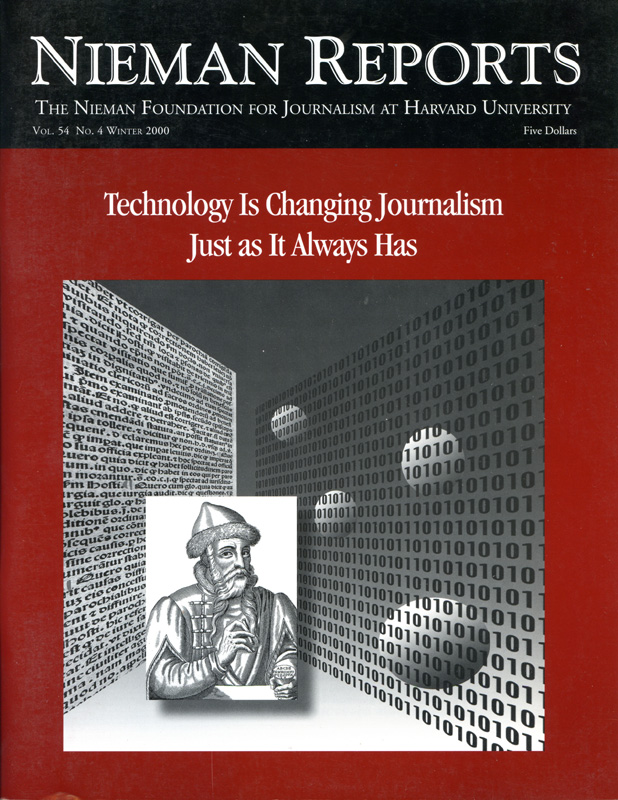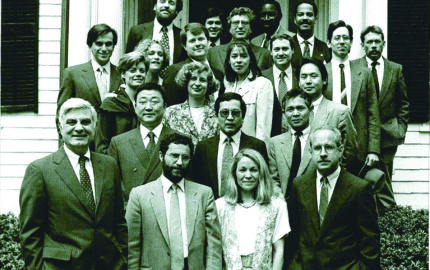Mainstream news organizations are struggling to apply old-fashioned news standards to the Web, but are discovering it is not easy to translate the virtues of accuracy, balance and clarity to a medium where the advantages of speed and timeliness prevail.
Web technology has strengthened the traditional watchdog functions of journalism by giving reporters efficient ways to probe more deeply for information. The capacity to search documents, compile background and historical context, and identify authoritative sources has expanded the reporter’s toolbox. It also has introduced a fundamentally different culture built on interactivity, fewer rules, and fewer limits.
Speed and timeliness once were the strength of newspapers. The wire services built their reputations on being first with the big stories, which people typically found in their local papers. The immediacy of television took that edge from the printed press. Now the Web has established its own advantages of speed and timeliness; and in doing so it has enabled newspapers to come full circle by posting breaking news and extending their brands through such innovations as online afternoon editions.
At the intersection of traditional journalism and the Web, attempts to apply the standards of the traditional newsroom encounter such other values as freedom, irreverence, advocacy and attitude. Web journalists argue that the Olympian tones of the traditional press don’t work online. They liken their new medium to the true spirit of the First Amendment and observe that it harkens back to a time when newspapers were feisty and combative. Ann Compton of ABCNews.com describes the essential difference between her online staff and the network’s television journalists: “We write more brightly. We throw in more slang. There is a richness to the dot-com coverage that you really can’t do on television.” Similar comparisons can be made between the Web and daily newspapers.
Is such “richness” compatible with the highest standards of journalism? Can the freewheeling, provocative, irreverent nature of the Web adapt to a culture whose traditions have been shaped by a more sober, structured medium?
The process of establishing standards online is moving along, influenced by three developments. First is the reality that the dominant news Web sites will be run by the old media—the traditional news organizations such as daily newspapers, newsmagazines and network and major cable television outlets. What makes this a reality is the influence of the marketplace, which has been especially harsh to upstart dot-coms. Those with insufficient capital or marginal journalistic reputations or weak marketing strategies are being weeded out. Among the survivors are the mainstream news organizations that have the resources to build powerful Web sites and to insure that these platforms reflect the rigorous standards by which their print publications are written and edited.
Second are efforts by online journalists to craft standards for the Web. The Online News Association is beginning a project to develop strong guidelines, including recommendations for how they can be applied and monitored. A grant from the John S. and James L. Knight Foundation will enable the Online News Association to hire a project director and meet a deadline of October 2001 for the guidelines it recommends.
Rich Jaroslovsky, president of the Online News Association and managing editor of The Wall Street Journal Interactive, says there is “a lot steam behind the project.” Too many online news decisions are being made “by the seat of the pants,” Jaroslovsky says, “rather than having a reason for the decision. We hope to develop a document that doesn’t direct but persuades,” not just journalists but also those who are working in other online cultures and making distinctions between news and commerce.
The third, and perhaps the most far-reaching influence on journalistic standards, is the interactivity that results when journalists put their e-mail addresses on the Web. E-mail can bring instant feedback to a story just posted as well as to one that is read in the newspaper over coffee in the morning. Some reporters are constructing barriers to such engagement with readers, preferring instead to not have e-mail or to be shielded by a filter that lets through only the messages they think they want to have.
E-mail enables reporters and editors to hear from people who may know something about the story and who can share an authoritative perspective, provide additional sources or raise the possibility that the story may be unbalanced or unfair. The potential for such interactivity is that it can contribute to raising the level of journalistic performance.
Jon Katz, a Web commentator who writes for Slashdot.com, says, “The surprising thing to me is the degree to which I am held accountable by readers for what I am doing. Whatever you are writing, your column makes its way to the most knowledgeable people on the subject…. What you learn is your column is not the last word, it’s the first word.”
Web technology has strengthened the traditional watchdog functions of journalism by giving reporters efficient ways to probe more deeply for information. The capacity to search documents, compile background and historical context, and identify authoritative sources has expanded the reporter’s toolbox. It also has introduced a fundamentally different culture built on interactivity, fewer rules, and fewer limits.
Speed and timeliness once were the strength of newspapers. The wire services built their reputations on being first with the big stories, which people typically found in their local papers. The immediacy of television took that edge from the printed press. Now the Web has established its own advantages of speed and timeliness; and in doing so it has enabled newspapers to come full circle by posting breaking news and extending their brands through such innovations as online afternoon editions.
At the intersection of traditional journalism and the Web, attempts to apply the standards of the traditional newsroom encounter such other values as freedom, irreverence, advocacy and attitude. Web journalists argue that the Olympian tones of the traditional press don’t work online. They liken their new medium to the true spirit of the First Amendment and observe that it harkens back to a time when newspapers were feisty and combative. Ann Compton of ABCNews.com describes the essential difference between her online staff and the network’s television journalists: “We write more brightly. We throw in more slang. There is a richness to the dot-com coverage that you really can’t do on television.” Similar comparisons can be made between the Web and daily newspapers.
Is such “richness” compatible with the highest standards of journalism? Can the freewheeling, provocative, irreverent nature of the Web adapt to a culture whose traditions have been shaped by a more sober, structured medium?
The process of establishing standards online is moving along, influenced by three developments. First is the reality that the dominant news Web sites will be run by the old media—the traditional news organizations such as daily newspapers, newsmagazines and network and major cable television outlets. What makes this a reality is the influence of the marketplace, which has been especially harsh to upstart dot-coms. Those with insufficient capital or marginal journalistic reputations or weak marketing strategies are being weeded out. Among the survivors are the mainstream news organizations that have the resources to build powerful Web sites and to insure that these platforms reflect the rigorous standards by which their print publications are written and edited.
Second are efforts by online journalists to craft standards for the Web. The Online News Association is beginning a project to develop strong guidelines, including recommendations for how they can be applied and monitored. A grant from the John S. and James L. Knight Foundation will enable the Online News Association to hire a project director and meet a deadline of October 2001 for the guidelines it recommends.
Rich Jaroslovsky, president of the Online News Association and managing editor of The Wall Street Journal Interactive, says there is “a lot steam behind the project.” Too many online news decisions are being made “by the seat of the pants,” Jaroslovsky says, “rather than having a reason for the decision. We hope to develop a document that doesn’t direct but persuades,” not just journalists but also those who are working in other online cultures and making distinctions between news and commerce.
The third, and perhaps the most far-reaching influence on journalistic standards, is the interactivity that results when journalists put their e-mail addresses on the Web. E-mail can bring instant feedback to a story just posted as well as to one that is read in the newspaper over coffee in the morning. Some reporters are constructing barriers to such engagement with readers, preferring instead to not have e-mail or to be shielded by a filter that lets through only the messages they think they want to have.
E-mail enables reporters and editors to hear from people who may know something about the story and who can share an authoritative perspective, provide additional sources or raise the possibility that the story may be unbalanced or unfair. The potential for such interactivity is that it can contribute to raising the level of journalistic performance.
Jon Katz, a Web commentator who writes for Slashdot.com, says, “The surprising thing to me is the degree to which I am held accountable by readers for what I am doing. Whatever you are writing, your column makes its way to the most knowledgeable people on the subject…. What you learn is your column is not the last word, it’s the first word.”



